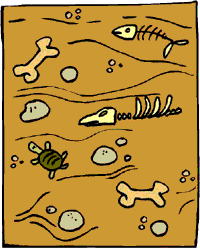|
Going,
Going, Gone!
The mixing
of dinosaurs also would have promoted the exchange of disease. The
introduction of new diseases into previously isolated populations
can be devastating. One example of disease exchange in the animal
kingdom is the infection of antelopes in Africa with the rinderpest
virus carried by cattle from India in the late 1800s. Another example
is the spread of Blackhead disease from domestic turkeys to heath
hens in the eastern United States in the early 1900s. Examples in
human history include the introduction of the Black Plague from
Asia into Europe during the Middle Ages and the spread of European
diseases among the native populations of the Americas and the Pacific
during the Age of Exploration. In each case, the local populations
were greatly reduced.
 So
in this explanation, species after species of dinosaur disappeared
due to shrinking habitats, increased competition, and disease, until
none were left. Is this what really happened to the dinosaurs? You
must look for evidence in the rocks of Earth. The climate did change
and the shallow seas did dry out, but did the dinosaurs disappear
slowly as suggested by this explanation? Did dinosaurs migrate between
continents? Is there any evidence of disease in the fossils? To
help you in your search, you might want to look up more information
in books or on the internet about disease, epidemics, dinosaur extinctions,
habitat fragmentation, and competition between species. Good luck!
Fossil
image © 1999 -www.arttoday.com So
in this explanation, species after species of dinosaur disappeared
due to shrinking habitats, increased competition, and disease, until
none were left. Is this what really happened to the dinosaurs? You
must look for evidence in the rocks of Earth. The climate did change
and the shallow seas did dry out, but did the dinosaurs disappear
slowly as suggested by this explanation? Did dinosaurs migrate between
continents? Is there any evidence of disease in the fossils? To
help you in your search, you might want to look up more information
in books or on the internet about disease, epidemics, dinosaur extinctions,
habitat fragmentation, and competition between species. Good luck!
Fossil
image © 1999 -www.arttoday.com
Back
|











